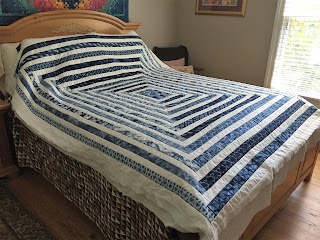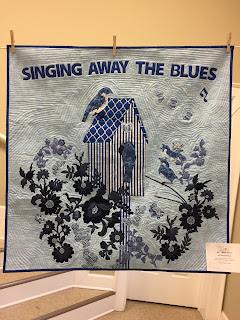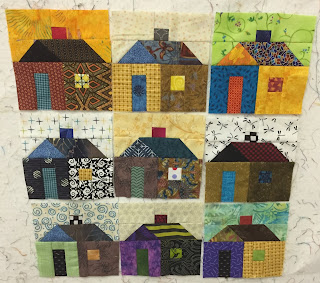I learned to quilt in 1985, before the Internet. It was possible, just different from the way many quilters learn today. There were a few books and lots of magazines. I learned a lot from magazines and began to buy books--I was very much a self-taught quilter in those early years.Over time I have accumulated a substantial library, almost 400 titles.
To be able to find the book I am looking for, they are filed alphabetically on these great IKEA bookcases in several categories: Amish, Applique', Children's Books, Clothing, Color, Design, Embellishment, Handwork, History, Miniatures, Pieced, Quilting, and Reference. By far, the largest number of books are in the Pieced category. And, yes, I have a spreadsheet.
When I tried to select my Top 10--the books I would keep until the very end--I just could not limit it to 10. So, here are my Top 15 Favorite Quilt Books.
15. Quilting: Patchwork and Applique' A Sunset Book
This is the first book I bought. It came from Hechinger's, a big-box store like Lowes in Northen Virginia. I can still remember reading it, and trying to understand the difference between "Patchwork" and "Quilting". For sentimental reasons, this is a keeper.
14. An Amish Adventure by Roberta Horton
This is the first book ever published by C&T Publishing. First published in 1983, it is still available today from their website as a print-on-demand title. I bought my copy in 1987, when my small guild, the Virginia Star Quilters of Fredericksburg, VA offered a weekly "class"--we met and worked on quilts from this book. I saw my first quilt as a 10 year old when my Girl Scout troop made a visit to Lancaster County, PA. I was smitten right then but it would be 20 more years before I began my quilting journey. I think it is time to start a similar "class"--solids are very popular again--Amish, the first Modern quilters.
13. Patchwork Patterns by Jinny Beyer
As a new quilter, I was in awe of this cover quilt, "Ray of Light" by Jinny Beyer. I clearly remember saying "Some day I want to be able to make a quilt like this." Years later, when I realized I was making a lot of Medallion-style quilts, I knew exactly where my inspiration came from. I am a huge fan of Jinny's and have been able to "talk quilt" with her many times. This book discusses hand piecing but designing and cutting out patchwork blocks is pretty much the same for machine piecing, the method I use most often. This book is full of great blocks--it opened my eyes to quilt design.
12. Clues in the Calico by Barbara Brackman
First published in 1989, I got mine about that time. It began my love affair with Quilt History, which in many ways is Women's History, and introduced me to the process of dating old quilts from their fabrics and patterns. In 1988 I bought my first old quilt top and later had it dated to about 1875 by Merikay Waldvogel, an expert in quilt history too. Using this book, I could see why she came up with that date. I have read this book cover-to-cover and learn something new each time I pick it up.
11. Heirloom Machine Quilting by Harriet Hargrave
Harriet made it OK to quilt our quilts by machine. I took classes from her in 1994, now I lived in Alabama and our guild, the Heritage Quilters of Huntsville, brought wonderful teachers for several workshops a year. I was making more quilt tops than I could hand-quilt so the "idea" of machine quilting was appealing. It's harder than it looks and I'm still learning to do adequate machine quilting. This book really helped me understand the process and provided lots of design ideas.
10. The Art of Machine Piecing and Drafting for the Creative Quilter, both by Sally Collins
The most professional quilt teacher I have ever taken a class from is Sally Collins. Besides being well-prepared in class, she really knows her stuff and makes the process of precise piecing understandable. "Drafting" scares quilters, but it's just a word for drawing a pattern and determining how to cut it out so the pieces fit together. I often tell my students "If you had known you were going to be a quilter, you would have paid more attention in Geometry class." I love "quilter's math" and the precise way patterns are created by color and cloth. These two books are like a Master's Class is quilt design. Have to keep them both.
9. Floral Applique' by Nancy Pearson
In 1989 my guild brought Nancy Pearson to teach needle-turn applique'. I was a convert right then, and loved everything about her beautiful designs. She was also one of the sweetest women I've ever met. She helped me with a quilt design I was working on in 2005, using one of her patterns as a starting point. It is one of my favorite quilts, partly because we discussed it during the design stage. I have taken many applique' classes since, but her love of beautiful applique' got me started.
8. The Quilter's Practical Guide to Color by Becky Goldsmith
I have several books on color--this is the one I have read cover-to-cover and have taught from. Many quilters struggle with "color theory" and think they are no good at color if they don't have an art background. This book makes basic concepts easy to understand and provides simple projects that teach those concepts.
7. All-in-One Rotary Cutting Magic by Nancy Johnson-Srebro
This little reference book is a great companion to Nancy's other books: Measure the Possibilities and Rotary Magic. The rotary cutter changed everything about quiltmaking and I am convinced it is the reason we have come so far. If we still had to cut out all our pieces by hand with scissors, most of us would not be quilters. This teaches "quilters math" in an easy way--whatever shape you want to cut out, from squares to trapezoids and prisms, you can easily see how to cut those shapes accurately.
6. Oh, Scrap! by Lissa Alexander
One of the most recent books I've bought, this one stays because there are several quilts in it I want to make. The subtitle "Fabulous Quilts that make the most of your Stash" says it all--I have a stash and I want to make fabulous quilts. Add to the fact Lissa is a great person who I enjoy talking to at Market every year--she words for MODA fabrics--and this is a keeper too.
5. Small & Scrappy by Kathleen Tracy
I have several of Kathleen's books. This one has a great subtitle: Pint-Size Patchwork Quilts Using Reproduction Fabrics. That is perfect for me. I love reproduction fabrics and make lots of small quilts. Each quilt in this book inspires me--I don't often follow the directions, but am inspired by her designs here to create my own similar quilts.
4. 19th Century Patchwork Divas' Treasury of Quilts by Betsy Chutchian and Carol Staehle
I have several of Betsy's books but this one reminds me how I fell head-over-heels in love with her group, the 19th Century Patchwork Divas'. Several years ago many of these quilts were in a Special Exhibit in Houston and I went back again and again over my two-weeks there to study and admire them. This is a group I want to be in--not just start one like it. It makes me happy to have gotten to know Betsy and I hope to take a class from her in the future. And if I start a group, what could be a better name? I am stumped, I think they have the best name ever.
3. Guide to Machine Quilting by Diane Gaudynski
Still intrigued with beautiful machine quilting. this book is a fantastic reference book for the process. Diane's work has always thrilled and inspired me. If only reading her words could make my quilting look like hers, I'd have it made. Alas, it takes lots of practice. I'm still working on it.
2. The Encyclopedia of Pieced Quilt Patterns by Barbara Brackman
The Bible of pieced quilt blocks. I look through this book frequently when designing a new quilt, looking for blocks I might not know. For appraisers, this book is a must as it provides not only names for almost every pieced block ever printed but the years and sources of those patterns. Barbara Brackman is a TREASURE as a quilt historian--I have learned so much from her books. This book is one of my most important titles.
1. The Art of Classic Quiltmaking by Sharyn Craig and Harriet Hargrave
If I could keep only ONE book, this is the one. We don't have great "process" books like this today, most are "project" books. This one covers all aspects of quiltmaking, from all the sizes of standard mattresses and what size quilt to make to fit them, to great quilt projects starting with simple scrap quilts all the way up to challenging curved-pieced blocks. There is an entire chapter on borders, another on quilting, another whole chapter on finishing--the binding, etc. This one book could teach a person most everything they need to know to be a great quilter. I am so thankful they wrote it, I still recommend students try to find a copy online and I have TWO copies--just in case something happens to the first one. It is my go-to reference book, hands down.
So, there you have it. Did one of your favorites make the list? What is your #1 book?
And, one bit of advice--if you have great quilt books, take time to READ them, not just look at the photos. They can teach you a lot.
Let's quilt!
Barbara






















































